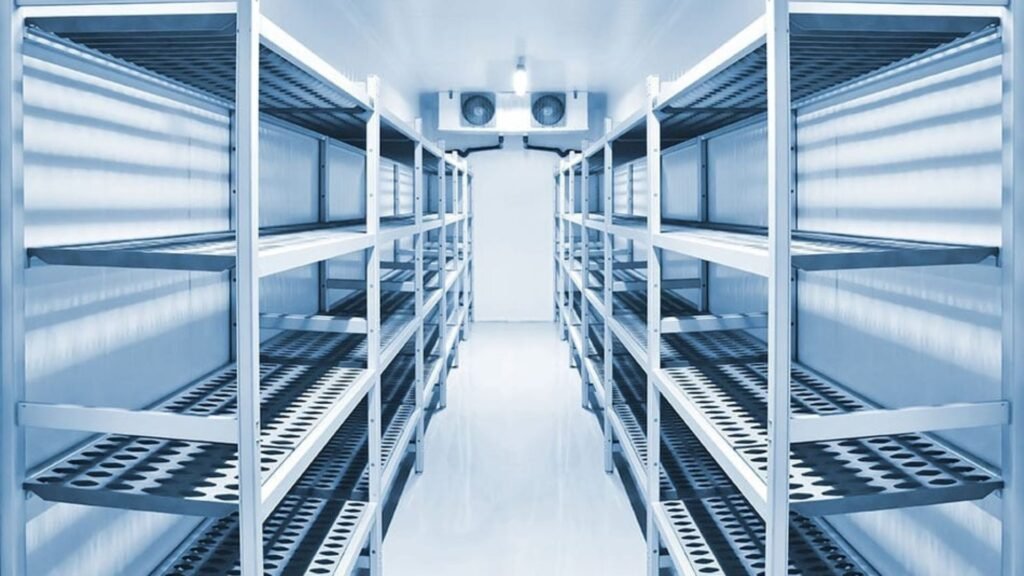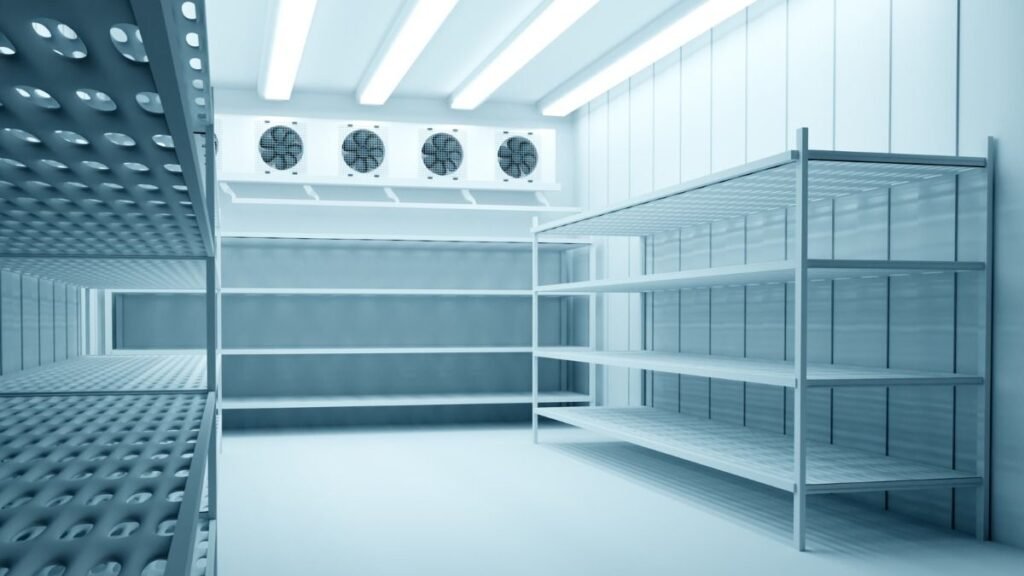Meta Description:
Explore expert cold storage design ideas to optimize distribution centers with smart layouts, efficient flow, and modern solutions for top-tier performance.

Cold Storage Design for Distribution Centers: A Practical Guide
In the world of supply chain management, cold storage design is more than just a refrigeration solution—it’s a crucial part of maintaining product quality, optimizing workflow, and saving energy. Whether you’re handling fresh produce, pharmaceuticals, or temperature-sensitive goods, the layout and functionality of your cold storage space can directly affect your efficiency and bottom line.
This guide focuses on cold storage design specifically for distribution centers, offering actionable tips to help you build a setup that performs smoothly, stays cost-effective, and scales with your business needs.
What Makes a Good Cold Storage Design?
A well-designed cold storage facility should do three things exceptionally well: maintain precise temperatures, support a seamless flow of goods, and minimize energy loss. But beyond that, it should also be safe, scalable, and easy to manage.
Here are some key principles behind effective cold storage design in distribution centers:
Efficient Zoning
Divide your cold storage space into clearly defined zones based on temperature needs and product types. This helps avoid unnecessary temperature fluctuations and prevents cross-contamination between goods.
Some typical cold storage zones include:
- Freezer zones for long-term frozen storage
- Chilled zones for perishable items
- Ambient zones for packaging and sorting
Having clearly marked and well-insulated zones ensures operational flow stays organized and energy isn’t wasted maintaining unneeded temperatures across the entire space.
Thoughtful Workflow Design
Layout is everything. Goods should move logically from receiving to storage to dispatch without doubling back or crossing over. Aim for a straight-line or U-shaped flow that minimizes handling time and reduces labor.
Key considerations include:
- Dock placement close to appropriate storage zones
- Designated staging areas for sorting and packing
- Wide, obstruction-free aisles for equipment movement
This clear path reduces confusion and keeps operations smooth, especially during peak hours.
Material Choices That Support Performance
The materials you choose for your cold storage facility play a vital role in both efficiency and maintenance. Durable, moisture-resistant, and easy-to-clean surfaces are a must in refrigerated environments.
Some smart choices include:
- Insulated metal panels (IMP) for walls and ceilings
- High-density polyurethane for insulation
- Non-slip epoxy flooring that resists moisture and bacteria
These materials ensure temperature retention, minimize contamination risk, and help the space hold up under heavy daily use.
Smart Technology for Smarter Storage
Modern cold storage design relies heavily on technology to monitor and maintain conditions efficiently. Smart systems allow you to track temperature fluctuations in real-time and adjust operations automatically.
Technological features to consider:
- Digital temperature monitoring with alerts
- Automated doors to prevent energy loss
- Motion-sensor lighting to reduce power consumption
- Energy-efficient cooling units with zoning controls
These upgrades make your cold storage safer, more sustainable, and easier to manage—even with minimal supervision.
Flexible Storage Solutions
Your inventory won’t always stay the same. That’s why it’s important to design a cold storage space that can adapt to changing volumes and new products.
Flexible storage options include:
- Adjustable racking systems to accommodate different pallet sizes
- Modular shelving units that can be reconfigured as needed
- Mobile cold storage containers for overflow or seasonal demand
Scalable design helps future-proof your distribution center and keeps you ready for growth.
Lighting and Visibility
Lighting is often overlooked in cold storage design, but it’s essential for safety and productivity. Cold environments require lighting that performs well at low temperatures and doesn’t generate excess heat.
Use LED lighting systems that:
- Are rated for cold temperatures
- Provide clear, uniform illumination
- Include motion sensors to reduce energy use
- Have easy-to-clean enclosures to prevent frost buildup
Proper lighting supports faster order picking, reduces errors, and improves overall workplace safety.
Safety and Compliance Considerations
Compliance with food safety, workplace safety, and energy regulations should be built into your design from day one. Skipping this step can lead to costly redesigns or fines later.
Make sure your cold storage layout includes:
- Slip-resistant flooring
- Emergency exits with clear signage
- Hygienic surfaces that meet health standards
- Temperature records accessible for audits
Designing with regulations in mind saves time and avoids legal headaches down the line.
Maintenance Access and Durability
Every element of your cold storage should be easy to clean, maintain, and repair. This includes installing walkable ceilings for HVAC access or ensuring wall panels can be replaced without dismantling major structures.
Build for durability by:
- Using corrosion-resistant materials
- Installing impact-resistant barriers at high-traffic points
- Ensuring space for equipment maintenance and ventilation
Well-thought-out details like these prevent downtime and keep operations moving.
Conclusion: Get Expert Help for Cold Storage Design That Works
Cold storage design is a key pillar of any successful distribution center. A smart layout doesn’t just preserve product quality—it improves workflows, cuts energy costs, and boosts long-term efficiency. At Good House Interiors, we bring a practical, expert-driven approach to planning cold storage solutions that are as efficient as they are future-ready.
From layout planning to selecting the right materials and systems, we’re here to help you create a cold storage space that ticks all the boxes. If you’re planning a new facility or upgrading an existing one, reach out to explore how we can support your project with thoughtful design and space optimization.
Frequently Asked Questions
What temperature zones should be included in a cold storage layout?
Typically, a good layout includes freezer zones (below -18°C), chilled zones (0°C to 5°C), and ambient areas for sorting or packing. Zoning depends on the products you store.
How can I reduce energy consumption in my cold storage facility?
Use high-efficiency insulation, install automated doors, choose LED lighting with motion sensors, and implement a smart temperature control system with zoning capabilities.
What flooring works best in cold storage environments?
Non-slip epoxy flooring is ideal. It’s moisture-resistant, hygienic, and built to withstand both cold temperatures and heavy foot or machinery traffic.
How do I ensure a smooth workflow in cold storage?
Plan a linear layout that moves goods from receiving to storage to dispatch without unnecessary backtracking. Wide aisles, clear signage, and proper zoning are key.
Can cold storage systems be expanded later?
Yes. Modular racking, flexible layouts, and mobile cooling units can all help scale your cold storage as your business grows.

تصميم التخزين البارد لمراكز التوزيع: دليل عملي
في عالم إدارة سلاسل الإمداد، يُعد تصميم التخزين البارد أكثر من مجرد حل للتبريد—بل هو عنصر أساسي للحفاظ على جودة المنتجات، وتحسين سير العمل، وتقليل استهلاك الطاقة. سواء كنت تتعامل مع المنتجات الطازجة أو الأدوية أو البضائع الحساسة للحرارة، فإن تخطيط التصميم وطريقة تشغيل مساحة التخزين البارد يمكن أن تؤثر بشكل مباشر على كفاءة العمليات وربحية العمل.
يركز هذا الدليل على تصميم التخزين البارد لمراكز التوزيع، ويقدّم نصائح عملية تساعدك على إنشاء مساحة فعالة من حيث الأداء، منخفضة التكاليف، وقابلة للتطوير مع نمو أعمالك.
ما الذي يجعل تصميم التخزين البارد جيدًا؟
ينبغي أن يحقق تصميم التخزين البارد الفعّال ثلاثة أهداف رئيسية: الحفاظ على درجات الحرارة الدقيقة، دعم انسيابية البضائع، وتقليل فقدان الطاقة. وبالإضافة إلى ذلك، يجب أن يكون التصميم آمنًا، وقابلًا للتوسع، وسهل الإدارة.
التقسيم الفعّال للمناطق
قسّم مساحة التخزين البارد إلى مناطق محددة بوضوح حسب احتياجات درجات الحرارة ونوع المنتجات. يساعد هذا في تجنب التقلبات غير المرغوب فيها في درجات الحرارة ويمنع التلوث المتبادل بين المواد.
من المناطق الشائعة في التخزين البارد:
- مناطق التجميد للتخزين طويل الأمد
- مناطق التبريد للمواد سريعة التلف
- مناطق ذات حرارة معتدلة للفرز والتغليف
تصميم سير العمل بعناية
التخطيط لمسار الحركة أمر بالغ الأهمية. يجب أن تنتقل البضائع من الاستلام إلى التخزين ثم إلى الشحن بطريقة منطقية دون تقاطعات أو عودة للخلف. اعتمد تصميمًا خطيًا أو على شكل حرف U لتحقيق أفضل تدفق.
عوامل رئيسية يجب مراعاتها:
- وضع الأرصفة قريبًا من مناطق التخزين المناسبة
- تحديد مناطق خاصة للفرز والتعبئة
- ممرات واسعة وخالية من العوائق لسهولة حركة المعدات
اختيار المواد المناسبة لدعم الأداء
تلعب المواد التي تُستخدم في تشييد التخزين البارد دورًا كبيرًا في الكفاءة وسهولة الصيانة. يجب أن تكون مقاومة للرطوبة، متينة، وسهلة التنظيف.
خيارك الذكي يشمل:
- ألواح معدنية معزولة للجدران والأسقف
- عزل من البولي يوريثين عالي الكثافة
- أرضيات إيبوكسية غير قابلة للانزلاق ومقاومة للبكتيريا
التكنولوجيا الذكية لتخزين أكثر ذكاءً
يعتمد تصميم التخزين البارد الحديث بشكل كبير على التكنولوجيا لمراقبة الظروف الداخلية والتحكم فيها بدقة. تتيح الأنظمة الذكية تتبع درجات الحرارة وضبط التشغيل تلقائيًا.
ميزات تكنولوجية يجب توفرها:
- مراقبة رقمية لدرجات الحرارة مع تنبيهات فورية
- أبواب آلية لتقليل فقد الطاقة
- إضاءة بمستشعرات حركة لتوفير الطاقة
- وحدات تبريد فعالة مع أنظمة تقسيم المناطق
حلول تخزين مرنة
لن تبقى مخزوناتك دائمًا على نفس الحجم أو الشكل. لذا، يجب أن تضمن تصميمًا مرنًا يمكنه التكيّف مع التغييرات.
تشمل الحلول المرنة:
- أنظمة رفوف قابلة للتعديل لتناسب أحجام مختلفة
- وحدات رفوف معيارية يمكن إعادة ترتيبها
- حاويات تخزين باردة متنقلة للطلب الموسمي أو الفائض
الإضاءة والرؤية
الإضاءة عامل مهم في بيئة التخزين البارد، ليس فقط للإنتاجية بل أيضًا للسلامة. تحتاج إلى إضاءة تعمل بكفاءة في درجات الحرارة المنخفضة دون إصدار حرارة زائدة.
الإضاءة المثالية تشمل:
- أنظمة إضاءة LED مناسبة للبيئات الباردة
- توزيع إضاءة متساوٍ وواضح
- مستشعرات حركة لتقليل استهلاك الكهرباء
- مصابيح محكمة الإغلاق لمنع تراكم الجليد
السلامة والامتثال
يجب أن يراعي التصميم الامتثال للوائح الصحة والسلامة والبيئة من البداية. تجاهل ذلك قد يؤدي إلى إعادة التصميم أو التعرض لغرامات.
تأكد من تضمين:
- أرضيات مقاومة للانزلاق
- مخارج طوارئ واضحة ومُعلّمة
- أسطح صحية مطابقة للمعايير الصحية
- سجلات درجات الحرارة سهلة الوصول
سهولة الصيانة والمتانة
يجب أن يكون كل عنصر في التخزين البارد سهل الصيانة والتنظيف والإصلاح. يشمل ذلك إمكانية الوصول إلى أنظمة التبريد وإمكانية استبدال الألواح بسهولة.
لضمان المتانة، ضع في اعتبارك:
- مواد مقاومة للتآكل والصدأ
- واقيات صدمات في مناطق المرور المرتفع
- مساحة كافية لصيانة المعدات والتهوية
الخاتمة: احصل على تصميم تخزين بارد يعمل بكفاءة
تصميم التخزين البارد هو أحد الأسس الرئيسية لنجاح أي مركز توزيع. التخطيط الذكي لا يحافظ فقط على جودة المنتجات، بل يُحسن الأداء، ويقلل التكاليف، ويُعزز من كفاءة العمل على المدى الطويل.
في Good House Interiors، نعتمد على خبرات عملية في تصميم حلول تخزين بارد فعالة، مدروسة، وقابلة للتنفيذ من اليوم الأول.
سواء كنت بصدد بناء منشأة جديدة أو تبحث عن تحسين منشأتك الحالية، تواصل معنا لتكتشف كيف يمكننا مساعدتك في تصميم توزيع مثالي يتوافق مع احتياجاتك التشغيلية والمستقبلية.
الأسئلة الشائعة
ما هي المناطق الأساسية التي يجب أن يحتوي عليها التخزين البارد؟
عادةً ما يتضمن التخزين البارد مناطق للتجميد (أقل من -18 درجة مئوية)، ومناطق للتبريد (بين 0 و 5 درجات)، ومناطق محيطة للتغليف أو الفرز.
كيف يمكنني تقليل استهلاك الطاقة في التخزين البارد؟
استخدم العزل عالي الكفاءة، الأبواب الآلية، إضاءة LED بمستشعرات حركة، وأنظمة تبريد ذكية تدعم تقسيم المناطق.
ما هو أفضل نوع أرضية للتخزين البارد؟
الأرضيات الإيبوكسية المقاومة للانزلاق هي الأفضل، حيث تتحمل الرطوبة ودرجات الحرارة المنخفضة والحركة الكثيفة للمعدات.
كيف أُحسّن تدفق العمل في التخزين البارد؟
خطط لمسار حركة خطي من الاستلام إلى التخزين ثم الشحن، مع ممرات واضحة ولافتات إرشادية وتنظيم جيد للمناطق.
هل يمكن توسيع التخزين البارد لاحقًا؟
نعم، يمكن ذلك من خلال تصميم مرن يشمل وحدات رفوف قابلة للتعديل، تخطيط مفتوح، وحاويات تبريد متنقلة عند الحاجة.
